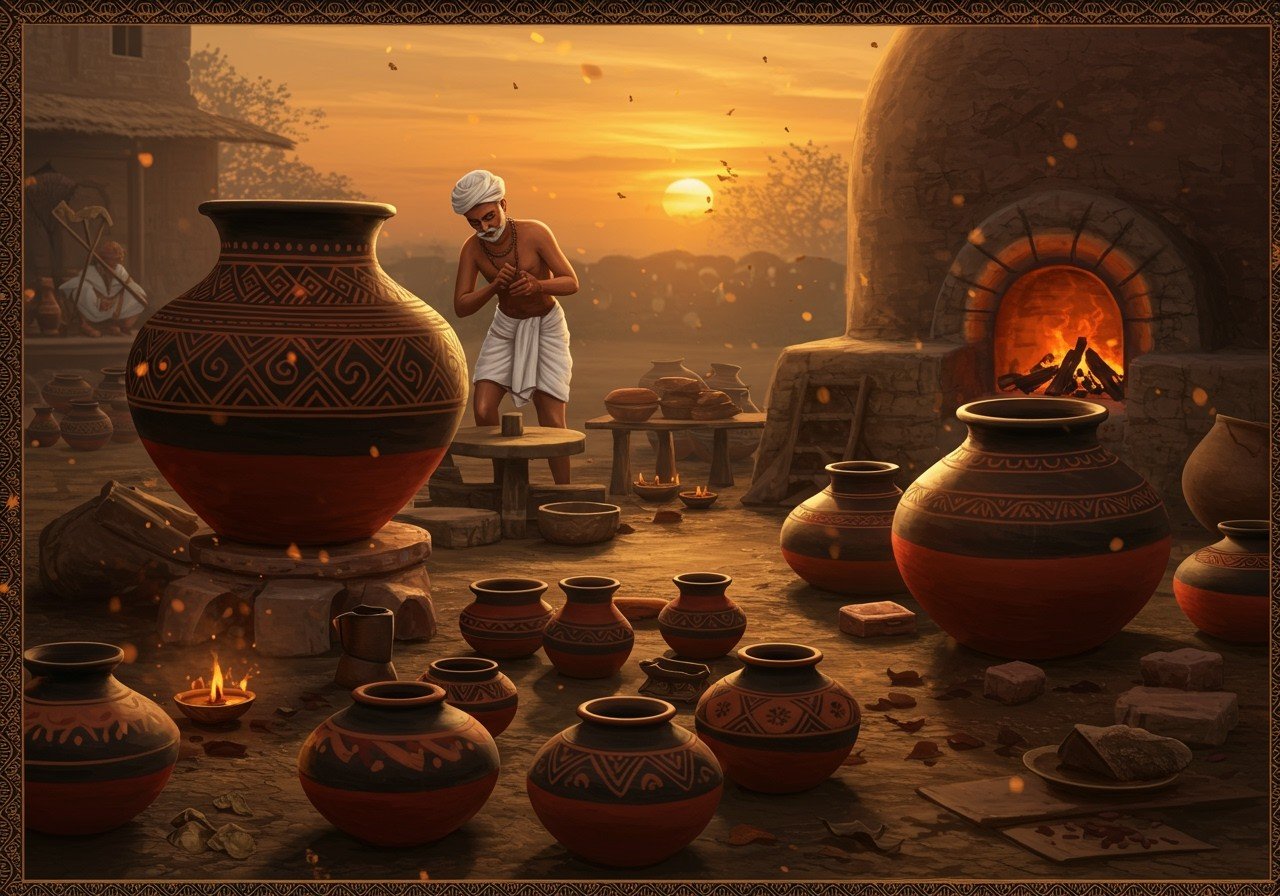
Ancient India, a land steeped in history and cultural heritage, presents the intriguing Black and Red Ware Culture. This pottery tradition, dating back to the early centuries of the Common Era (around 700 BCE to 200 CE), offers valuable insights into the region’s social and economic dynamics. Let’s delve into the significance, craftsmanship, and historical context of this unique pottery style.
Origins and Historical Context
The Black and Red Ware Culture emerged around 700 BCE, flourishing until approximately 200 CE. It’s linked to the later stages of the Indus Valley Civilization (3300 BCE to 1300 BCE), known for its advanced pottery techniques, including polychrome pottery with geometric patterns and incised ware. This connection highlights a continuous evolution of pottery traditions in the region.
Geographical Spread and Significance
This pottery style spread across various regions, notably Maharashtra, Gujarat, and parts of Southern India. Its presence signifies not only the reach of this tradition but also the potential trade networks and cultural exchanges during that era. The pottery played a significant role in daily life, trade, and rituals, reflecting its importance in ancient Indian society.
The Chalcolithic Period to the Iron Age
The transition from the Chalcolithic period to the Iron Age brought significant changes in pottery styles. Black and Red Ware emerged during this transformative period, showcasing the adaptability and innovation of ancient Indian artisans. The shift in technology and materials reflects the evolving needs and artistic sensibilities of the time.
Archaeological Evidence and Indus Influence
Archaeological sites like Nevasa, Maheshwar, and Inamgaon have yielded substantial Black and Red Ware pottery, providing glimpses into daily life, rituals, and economic activities. The techniques and styles show influences from the earlier Indus Valley Civilization, especially in the use of geometric patterns and the high level of craftsmanship. This continuity underscores the lasting impact of the Indus Valley Civilization on later pottery traditions.
Characteristics and Craftsmanship
The distinct black and red colors of this pottery are achieved through specialized firing techniques, requiring precise control of temperature and oxygen. This process highlights the technical expertise of the ancient potters.
Materials, Shapes, and Motifs
The pottery is crafted from fine clay, with regional variations contributing to the diversity of styles. Common shapes include bowls, jars, and plates, demonstrating both functionality and aesthetic sensibility. Geometric designs and animal figures are frequent motifs, potentially carrying symbolic meanings related to cultural beliefs and practices.
The Role of Craftsmen and Color Symbolism
Skilled potters held a significant social role. Their expertise was essential for creating functional and beautiful objects, contributing to the community’s cultural and economic life. The black and red colors likely held symbolic meaning, possibly connected to rituals or social status.
Archaeological Discoveries and Research
Excavations at major sites continue to unearth Black and Red Ware pottery, enriching our understanding of ancient Indian life. These discoveries provide insights into social structures, economic activities, and technological advancements. Interdisciplinary research, combining archaeology, anthropology, and history, offers a comprehensive perspective on this fascinating culture.
Modern Clay Dining Sets: Connecting with Ancient Indian Heritage
At Poojn.in, we offer premium clay dinner sets that connect you with India’s ancient pottery traditions. Our handcrafted sets feature:
- Premium fired clay construction, echoing ancient techniques. The firing process is carefully controlled to achieve the rich, earthy tones reminiscent of traditional pottery.
- Traditional red hues that reflect the historic Black and Red Ware culture. The color palette is inspired by the iconic black and red pottery, creating a link to India’s rich heritage.
- Hand-printed designs by skilled artisans, adding a unique touch to each piece. Our artisans draw inspiration from traditional motifs and patterns, ensuring each set is a work of art.
- Complete dining set with 12-inch plates, bowls, and glasses, perfect for everyday use or special occasions. The sets are designed to be both functional and beautiful, enhancing your dining experience.
These sets are ideal for those seeking a traditional Indian dining experience while appreciating the artistry of ancient pottery. Each piece is meticulously crafted using Camlin Fabrica acrylic colors and features unique hand-printed designs. Our clay dinner sets are available in various regional styles and come with secure packaging. We offer refunds for broken items (with proof) and accept prepaid orders only.
Visit Poojn.in to discover our exquisite collection of clay dinner sets and bring a piece of ancient Indian pottery tradition to your home. You can also check out our 9-inch clay dinner sets and other variations.
FAQs on Black and Red Ware Culture
What is Black and Red Ware Culture? Black and Red Ware Culture refers to a distinctive pottery tradition in ancient India, characterized by its striking black and red colors. This pottery style played a significant role in the daily lives and cultural practices of ancient Indian communities.
Where is Black and Red Ware Culture found in India? This pottery tradition is primarily found in regions like Maharashtra, Gujarat, and parts of Southern India. Its distribution suggests potential trade routes and cultural connections between these areas.
Why is Black and Red Ware important? Black and Red Ware is crucial for archaeological studies as it provides insights into ancient Indian societies, their technological advancements, artistic expressions, and daily routines. The pottery’s presence helps researchers understand the cultural and economic landscape of the time.
How old is Black and Red Ware Culture? The Black and Red Ware Culture dates back to around 700 BCE and flourished until approximately 200 CE. This period coincides with significant developments in ancient Indian history, including the transition from the Chalcolithic period to the Iron Age.
Conclusion
Exploring the Black and Red Ware Culture offers a captivating glimpse into ancient India’s ingenuity and artistry. This pottery tradition embodies the enduring legacy of India’s rich heritage, connecting us to the cultural practices and technological achievements of our ancestors. By understanding the significance and craftsmanship of Black and Red Ware, we gain a deeper appreciation for the rich tapestry of Indian history.


